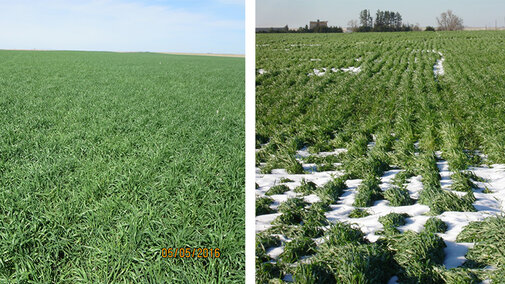Although Nebraska’s planted wheat acres are at record lows, producers should expect high yields. Favorable growing conditions, including a mild winter and abundant precipitation, has Nebraska wheat positioned to achieve wheat yields not seen in the past five years.
However, farmers should scout carefully for wheat rust and be prepared to treat any outbreaks in a timely manner.
The most recent crop condition report from the USDA’s National Agricultural Statistic Service (NASS) rated 60% of Nebraska’s winter wheat crop as good or excellent. The same report released the same week of 2015 rated 35% of the winter wheat crop as good or excellent, whereas 2014 was 46%.
Last year’s winter wheat crop suffered several weather-related blows. Parts of western Nebraska suffered substantial winter kill. A severe winter storm in mid-May broke wheat stems and caused freeze injury. Then widespread rust infected wheat across the state. The statewide yield average in 2015 was 38 bushels per acre. Yields in 2014 to 2011 were 49, 35, 41, and 45 bushels per acre, respectively.
The first freeze last fall came nearly a month late, which allowed the winter wheat more time to establish. The wheat entered winter in excellent condition, and the mild weather resulted in very minimal winter kill. Periods of sustained cold temperatures or wild fluctuations in temperature that would normally harm wheat were mostly absent.
Throughout the winter and continuing into this spring, strong storms refilled much of the soil profile with water. The latest topsoil moisture conditions as reported by the USDA NASS are higher than the same weeks in 2015 and 2014. In the most recent report, 88% of topsoil moisture was rated as adequate and surplus, compared to 64% in 2015 and 49% in 2014.
Winter wheat that is currently rated high for condition and plenty of soil moisture has the potential to produce high wheat yields. Kent Lorens with the Nebraska Wheat Board recently estimated that Nebraska wheat yields could average 55 bushels per acre this year. Current surveys from western Nebraska have shown support for dryland wheat yields approaching the 50 bushel per acre threshold.


Scout Wheat Fields Early and Often
Understanding the potential yield of the wheat crop is important when making management decisions. Decisions on inputs, whether for fertility, weed control, or disease control, must be based on the potential yield and value of the crop. (See this week's Wheat Disease Update.)
With reports of wheat rust moving throughout Kansas and into Nebraska, frequent scouting and timely applications of fungicides are important to protect this year’s crop. A fungicide application made to protect the flag leaf in a severe rust outbreak will easily pay for the chemical and application costs. Without the fungicide, a yield loss of 20-30 bushels per acre should be expected if the wheat variety is susceptible and the field would otherwise become heavily infested.
This year’s wheat crop is much further along in development than previous years, with nearly 60% of the crop jointed at the beginning of May. Monitor the wheat growth stage of your fields to ensure timely application of inputs. As this wheat crop is about two weeks ahead in development, fungicide applications will need to be made earlier than normal to protect the flag leaf and potential yields.
For more information on how to manage leaf rust in winter wheat, see the Leaf Rust entry in the Wheat Disease Management section of CropWatch.
Recent Cold Weather
Recent storms brought cold temperatures and snow to much of western Nebraska. The level of injury to the wheat depends on the growth stage and the amount of time spent below 28°F (Figures 2-3). Figure 4 shows areas that fell below 28°F and for how many hours during a 24-hour period from May 1 to May 2.
Due to the current growth stage of the wheat impacted by the recent low temperatures, any injury is expected to be minimal.
In the southern area of southwest Nebraska, wheat is just starting to head, a critical time for freeze injury. (On May 9-10 1981 most of the wheat crop in Red Willow County was lost when a freeze hit just after the crop had headed.)
For more information on how to assess freeze injury in winter wheat, see the Nebraska Extension publication, Freeze Injury to Nebraska Wheat (EC132) and CropWatch.unl.edu/wheat.

